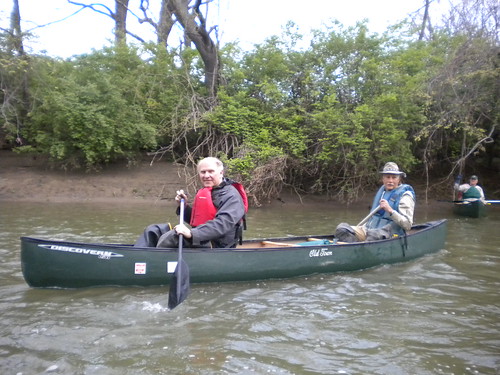Congress is not in session this week, so rather than being in Washington, I’m back home in Cincinnati. Two days ago (Monday), after visiting La Salle High School (my alma mater) and congratulating them on winning the Ohio State Division One Basketball Championship, I headed down North Bend Road in my ’93 Buick to the Mill Creek. The Mill Creek, which was named “the most endangered urban river in North America” back in 1997, runs 28 miles from Liberty Township in Butler County to the Ohio River, just west of downtown Cincinnati.
I had canoed the Mill Creek about eight years ago from Northside to the Ohio; this time I canoed from Evendale to Caldwell Park on North Bend Road, a distance of about six miles. I was accompanied by University of Cincinnati Professor of Biology Mike Miller, and a number of other environmentalists. Professor Miller is one of the top authorities on the Mill Creek, its environmental condition, its impact on our community, its restoration, wildlife, etc.
The Metropolitan Sewer District (MSD) entered into a federal consent decree back in 2004 to improve the Mill Creek water quality and reduce the number of combined sewer overflows. The City acknowledged that it was not in compliance with the Clean Water Act.
Many people think of the Mill Creek as basically an open sewer. And when you see it from I-75, much of it is concrete trenches installed by the U.S. Army Corp of Engineers back in the 1970’s and ‘80’s. When we have a heavy rain event, untreated sewage can and does flow into the Mill Creek and then into the Ohio River. And of course the Ohio River is our main source of drinking water in this area, albeit upriver from where the Mill Creek dumps into the Ohio. But we are upriver from other communities getting their drinking water from the Ohio. So we’re all in this together.
When I took my canoe trip eight years ago, I remember getting a warning in writing which said “Ohio EPA recommends no contact with waters of the Mill Creek because it has excessive levels of fecal coliform bacteria and other pathogens from time to time. If you have an open wound or weakened immunities you should not go.” Either it’s cleaner now, or they forgot to give me the warning, but nobody mentioned it this time. (Besides I wasn’t aware of any open cuts I had, and as far as I know my immunities aren’t weakened in any way, so I figured I’d survive. I did.)
My impressions of the Mill Creek at the present time? Yes, the Restoration Project has quite a ways to go yet. We saw a truck axle and tires in the creek, piles of roof shingles along its banks, lots of pieces of plastic garbage bags, and of course toilet paper. But in many sections, the trees, greenery, and especially the wildlife were quite remarkable. Among other things we saw a huge red-tailed hawk (near its nest, which I also saw), great blue heron, kingfishers, a muskrat, miscellaneous fish (a good-sized carp) and evidence of beaver.
Now some of the money for the long-term cleanup and restoration of the Mill Creek is local, and much of it is federal. And whereas everyone knows by now that I’m a fiscal conservative, and I believe significant cuts in federal spending must occur, I do believe that federal funding for the revitalization of the Mill Creek is important, and I will continue to fight for a reasonable and appropriate level of federal funding. And our goals for the cleanup of the Mill Creek must be realistic as well – we can’t afford to ignore history and several centuries of industrial use of the Mill Creek as a dumping ground – i.e. we can’t afford to make the Mill Creek so pristine that we could comfortably drink from it, or even swim in it. Canoeing and boating, fine. Bike trails, hiking paths, greenways, occasional parks, great. But we must be realistic.
I’d love to hear your thoughts. Drop me a message on Facebook or shoot me an email at chabotcups@chabotforcongress.com. See you next week.


